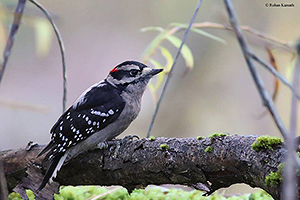 |
Downy Woodpecker
Picoides pubescens |
|
|
STANFORD LOCATIONS: Fairly common resident, breeding in a number of areas on campus. |
 |
Location |
Type |
Mating System |
Parental Care |
2ndary Diet |
Strategy |
|
|
|
|
I: 12 DAYS ALTRICIAL |
|
|
|
|
|
(3-6) MONOG |
MF |
| BREEDING: | Decid and mixed decid-conif woodland, riparian woodland, parks, orchards. 1 brood in n, 2? in s. |
| DISPLAYS: | "Dancing," drumming, bill waving, crest raising used in territorial displays and with duetting in courtship. Stilted, floating flight occurs in both aggression and courtship. |
| NEST: | New hole yearly, entrance often camouflaged by surrounding fungus/lichen/moss. Lined with chips. Excavated in 13-20 days (avg 16). Female usu selects site. |
| EGGS: | White. 0.8" (19 mm). |
| DIET: | Insects (75 to 85%); fruit, seeds, sap from sapsucker holes. |
| CONSERVATION: | Resident. Occ uses birdhouse for roost but not for nest. |
| NOTES: | Pair initially hold large territory which shrinks after nest site selected and excavated. Male reportedly performs most of brooding. Fledglings dependent for up to 3 weeks. Sexes forage separately: males prefer small branches, upper canopy and branches <60o from horizontal. Other hole-nesting species may invade roosting holes or nests. Each bird excavates winter roost. |
| ESSAYS: | Island Biogeography; Bird Guilds; How Do We Find Out About Bird Biology?; Feeding Birds; Nonvocal Sounds; Mixed-Species Flocking; Territoriality. |
| REFERENCES: | Killiam, 1983; Lawrence, 1967; Short, 1982. |
| Help | Abbreviations | Species-Alphabetical | Species-Taxonomic | Essays-Alphabetical | |
| Except for Stanford Locations, the material in this species treatment is taken, with permission, from The Birder's Handbook (Paul Ehrlich, David Dobkin, & Darryl Wheye, Simon & Schuster, NY. 1988). | |||||